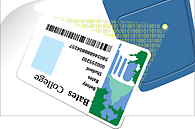Quad Angles
Cards are Key
Edited by H. Jay Burns and Doug Hubley
Cards are upstaging keys for unlocking doors at Bates, as an electronic access system featuring proximity ID cards is phased in this year. The system is the most obvious component of a security upgrade costing around $3 million.

New chief, new electronic access system for Bates
Replacing traditional key access, the “prox cards” will give students, faculty, and staff flexible access to 60 residential, academic, library, and athletic buildings. The cards resemble, and will replace, the familiar BatesCard.
“Since 1997, and particularly after September 11, in many ways the way campuses look at security has changed,” says Bates’ director of Security and Campus Safety, Thomas Carey ’73, who headed the FBI’s Domestic Terrorism Operations Section before starting at Bates last summer.
In addition, security awareness was heightened by the rape of a Bates student in an academic building by an outsider on campus during 2002. Later that year, the College created the Security and Access Group, chaired by Associate Vice President for Academic Affairs Gene Wiemers.
“We were asked to make recommendations that would improve the security of access to campus buildings, improve the perception of security in the campus community, and at the same time preserve the sense of openness characteristic of Bates,” Wiemers says.
In consultation with the worldwide firm Kroll Security Services, Bates is implementing all the recommendations from Wiemers’ group:
- improved exterior lighting, in consultation with LAM Partners of Cambridge, Mass.;
- installation, by Barry Security Systems of Tewksbury, Mass., of the card access system and its integrated sensors and alarms;
- installation of access monitoring stations in the Security office;
- creation of a convenient Chase Hall office to administer the ID system.
As Wiemers points out, the most important steps to improving security “are educational and procedural.” And so one goal of the access system is to eliminate the student custom of propping campus doors open. Typically, during the school year, Security officers find more than 100 propped doors per month.
For a residence hall, here’s how the system will work: Placed within six inches of a sensor, the card unlocks the door and changes the sensor’s lights from red to green for five seconds. If the door is still open after 20 seconds, the sensor beeps. After 30 seconds, that beep becomes a 95-decibel alarm that continues until the door is closed. The alarm automatically notifies Security, which dispatches an officer and sets in motion a possible fine of up to $900.
“We don’t want any money what we want is compliance,” Carey says. “If residents close a door before an officer arrives, there will be no fine. But we cannot have doors propped open.”
Reliable electronic access, Wiemers says, should enhance the sense of openness at Bates by allowing people to move freely among buildings where they need to be, without leaving doors open to anyone who happens by. “It can also free Security personnel from unpropping doors or letting students into buildings in the evening, so they can spend more time patrolling and performing other essential security functions,” he says.
Carey, a government major at Bates who began his law enforcement career as a Lewiston patrolman in 1973

Thomas Carey ’73
, most recently ran domestic terrorism operations for the FBI in Washington, D.C. In 2001-02, he was the inspector in charge of the investigation into the four anthrax-tainted letters that killed five people.
From 1999 to 2002, Carey headed up the FBI’s counterterrorism measures for a variety of high-profile public events, including the 2001 presidential inauguration, Democratic and Republican political conventions, the 2002 Winter Olympics in Salt Lake City and the September 11 investigations in Washington.